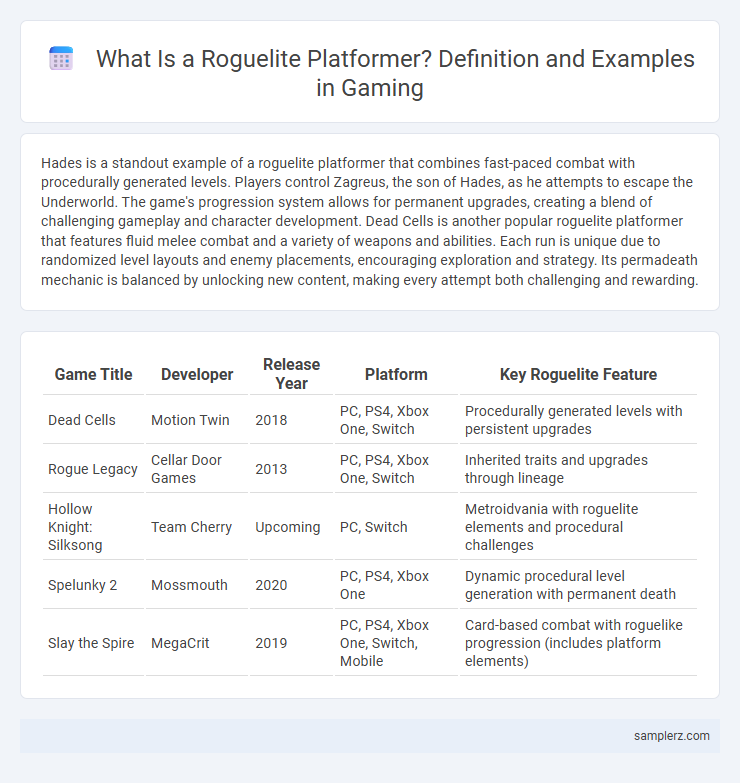Hades is a standout example of a roguelite platformer that combines fast-paced combat with procedurally generated levels. Players control Zagreus, the son of Hades, as he attempts to escape the Underworld. The game's progression system allows for permanent upgrades, creating a blend of challenging gameplay and character development. Dead Cells is another popular roguelite platformer that features fluid melee combat and a variety of weapons and abilities. Each run is unique due to randomized level layouts and enemy placements, encouraging exploration and strategy. Its permadeath mechanic is balanced by unlocking new content, making every attempt both challenging and rewarding.
Table of Comparison
| Game Title | Developer | Release Year | Platform | Key Roguelite Feature |
|---|---|---|---|---|
| Dead Cells | Motion Twin | 2018 | PC, PS4, Xbox One, Switch | Procedurally generated levels with persistent upgrades |
| Rogue Legacy | Cellar Door Games | 2013 | PC, PS4, Xbox One, Switch | Inherited traits and upgrades through lineage |
| Hollow Knight: Silksong | Team Cherry | Upcoming | PC, Switch | Metroidvania with roguelite elements and procedural challenges |
| Spelunky 2 | Mossmouth | 2020 | PC, PS4, Xbox One | Dynamic procedural level generation with permanent death |
| Slay the Spire | MegaCrit | 2019 | PC, PS4, Xbox One, Switch, Mobile | Card-based combat with roguelike progression (includes platform elements) |
Defining Roguelite Platformers: Key Characteristics
Roguelite platformers blend procedurally generated levels with permanent character progression, offering a balance between challenge and player growth. Key characteristics include permadeath combined with partial persistence, randomized environments, and skill-based gameplay that emphasizes agility and exploration. Titles like Dead Cells exemplify these features by merging fast-paced platforming with roguelike-inspired mechanics to enhance replayability.
Top Roguelite Platformers You Should Play
Hades stands out as a top roguelite platformer, blending fast-paced combat with procedurally generated levels and deep narrative elements. Dead Cells offers fluid movement and challenging enemy encounters, making it a benchmark for the genre with its pixel art style and permanent upgrades. Rogue Legacy 2 combines genetic traits and castle exploration, providing unique character progression and replayability in a roguelite platforming experience.
Classic Influences: Early Roguelite Platformer Examples
Early roguelite platformers such as Spelunky and Rogue Legacy set the foundation for the genre by combining randomized level design with permanent character progression and permadeath mechanics. These titles drew heavy inspiration from classic games like Rogue and Metroid, emphasizing challenging gameplay and replayability through procedural generation. Their innovative blend of platforming and roguelite elements continues to influence modern game design.
Procedural Generation in Platformers: A Roguelite Staple
Procedural generation in platformers like Dead Cells creates unique levels each playthrough, enhancing replayability and challenge. This technique dynamically assembles environments from modular segments, ensuring unpredictable layouts that test player adaptability. Roguelite platformers leverage procedural generation to blend randomized exploration with skill-based progression, defining the genre's core appeal.
Permadeath and Progression in Roguelite Platformers
Roguelite platformers like Dead Cells exemplify the blend of permadeath with persistent progression, where players restart after death but retain certain upgrades or abilities that enhance subsequent runs. This design balances high-stakes challenges with a sense of long-term growth, encouraging repeated playthroughs and skill improvement. Implementing permadeath alongside incremental progression maintains the addictive cycle of risk and reward central to the roguelite experience.
Iconic Indie Roguelite Platformers
Iconic indie roguelite platformers like "Dead Cells" and "Spelunky 2" have defined the genre with their procedurally generated levels and permanent death mechanics. "Dead Cells" combines fast-paced combat with Metroidvania-inspired exploration, while "Spelunky 2" emphasizes careful resource management and randomized environments. Both titles showcase how indie developers innovate within the roguelite format to deliver challenging and replayable platforming experiences.
Evolution of Roguelite Mechanics in Platformer Games
Roguelite platformers like Dead Cells and Rogue Legacy exemplify the evolution of roguelite mechanics by integrating procedural level generation with persistent progression systems. These games balance randomized challenges and player skill development by incorporating meta-upgrades and character customization that persist across deaths. The fusion of permadeath elements with evolving gameplay loops in platformers has redefined replayability and player engagement within the roguelite subgenre.
Multiplayer Roguelite Platformer Experiences
Multiplayer roguelite platformer experiences combine procedurally generated levels with cooperative or competitive gameplay, offering dynamic replayability and thrilling challenges for players. Titles like Risk of Rain 2 and Spelunky 2 exemplify this genre, featuring varied character abilities, randomized environments, and permadeath mechanics that encourage teamwork and strategic adaptability. These games push the boundaries of traditional platformers by emphasizing player interaction alongside evolving stage design and loot progression systems.
Influential Art Styles in Roguelite Platformers
Roguelite platformers like *Dead Cells* showcase a pixel art style that merges retro aesthetics with fluid animation, creating an immersive gameplay experience. *Hades* utilizes vibrant hand-drawn artwork influenced by Greek mythology, enhancing narrative depth and character design. *Celeste* features minimalist yet expressive pixel art that emphasizes emotional storytelling and precise platforming mechanics.
Future Trends for Roguelite Platformers
Future trends for roguelite platformers emphasize increasingly procedural level generation combined with adaptive AI to create unique, challenging experiences for each playthrough. Enhanced character progression systems incorporating meta-upgrades and customization options will deepen player investment and replayability. Integration of multiplayer elements and live service models will also expand community engagement and content longevity in this evolving genre.

example of roguelite in platformer Infographic
 samplerz.com
samplerz.com